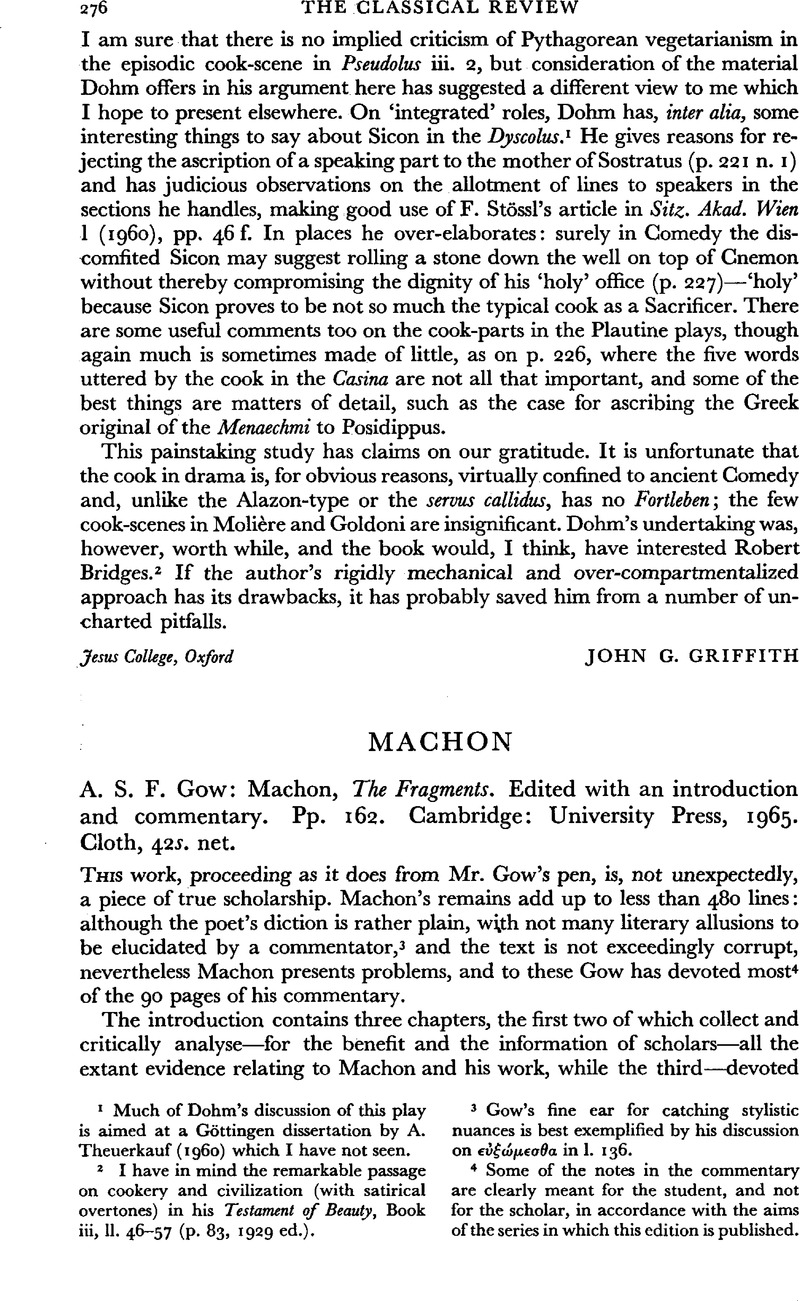No CrossRef data available.
Article contents
Machon - A. S. F. Gow: Machon, The Fragments. Edited with an introduction and commentary. Pp. 162. Cambridge: University Press, 1965. Cloth, 42s. net.
Published online by Cambridge University Press: 27 February 2009
Abstract

- Type
- Reviews
- Information
- Copyright
- Copyright © The Classical Association 1965
References
page 276 note 3 Gow's fine ear for catching stylistic nuances is best exemplified by his discussion on εὐξώμεσθα in I. 136.
page 276 note 4 Some of the notes in the commentary are clearly meant for the student, and not for the scholar, in accordance with the aims of the series in which this edition is published.
page 277 note 1 e.g. p. 4 n. 4 the ‘Misc. Aless. in hon. [sic] Rostagni, A. is the ‘Miscellanea di Studi Alessandrini in memoria di A. Rostagni’, Torino, 1963; footnotes like p. 27 n. 4 (‘L. Eldick, in a Münster Dissertation of 1928’) compel the reader to waste time in consulting the usual bibliographical repertories. In the discussion (p. 120) on καιρίμην it would have been better to add Proleg. after Lobeck. Path.Google Scholar
page 277 note 2 p. 88 I. 14, read ‘paratragic’; p. 91 I.23, read ‘is’;p. 991.5 from the bottom, and p. 101 I. 16, restore circumflex accents; p. 99 I. 15, read indef. pron.
page 277 note 3 I hope to devote a special note to this problem.
page 278 note 1 The ἔχει is used by Alkenor ambiguously in the sense ‘inhabits’ (the pebbles; in Alkenor's calembour the singular ψῆφον is meant to be taken as a collective; cf., e.g., its exact synonym κάχληκα Thuc. iv. 26. 2: = ‘shingle’, ‘Kies’, ‘ghiaia’, cf. K.G. i, p. 13, 1) and in the sense ‘has, possesses’ (the dining pledge).
page 278 note 2 The King asked why Archephon was not eating the κωβιοί, not why Archephon was eating fish other than the κωβιοί: if the King's question had been phrased in this latter form, Alkenor's calembour would of course have been impossible.
page 278 note 3 Cf. μαστιγία Epitr. 755 = Machon 285 μαστιγίας, Epitr. 635 νὴ τὴν φίλην Δήμητρα = Machon 293 ναὶ τὴν φίλην Δήμητρα.
page 278 note 4 The corruption of σιπαλόν into λιπαρόν is probably pre-medieval: in the Alexandrian cursive, Ϲ of the ‘broken type’ can resemble, if its flattened head is inclined downwards (Ϲ), a Λ, whilst a Λ can be mistaken for an ‘open’ Ρ (i.e. Ρ). In the medieval minuscule λ and ρ are, of course, constantly confused (-λον = -ρον), but not σ and λ.


